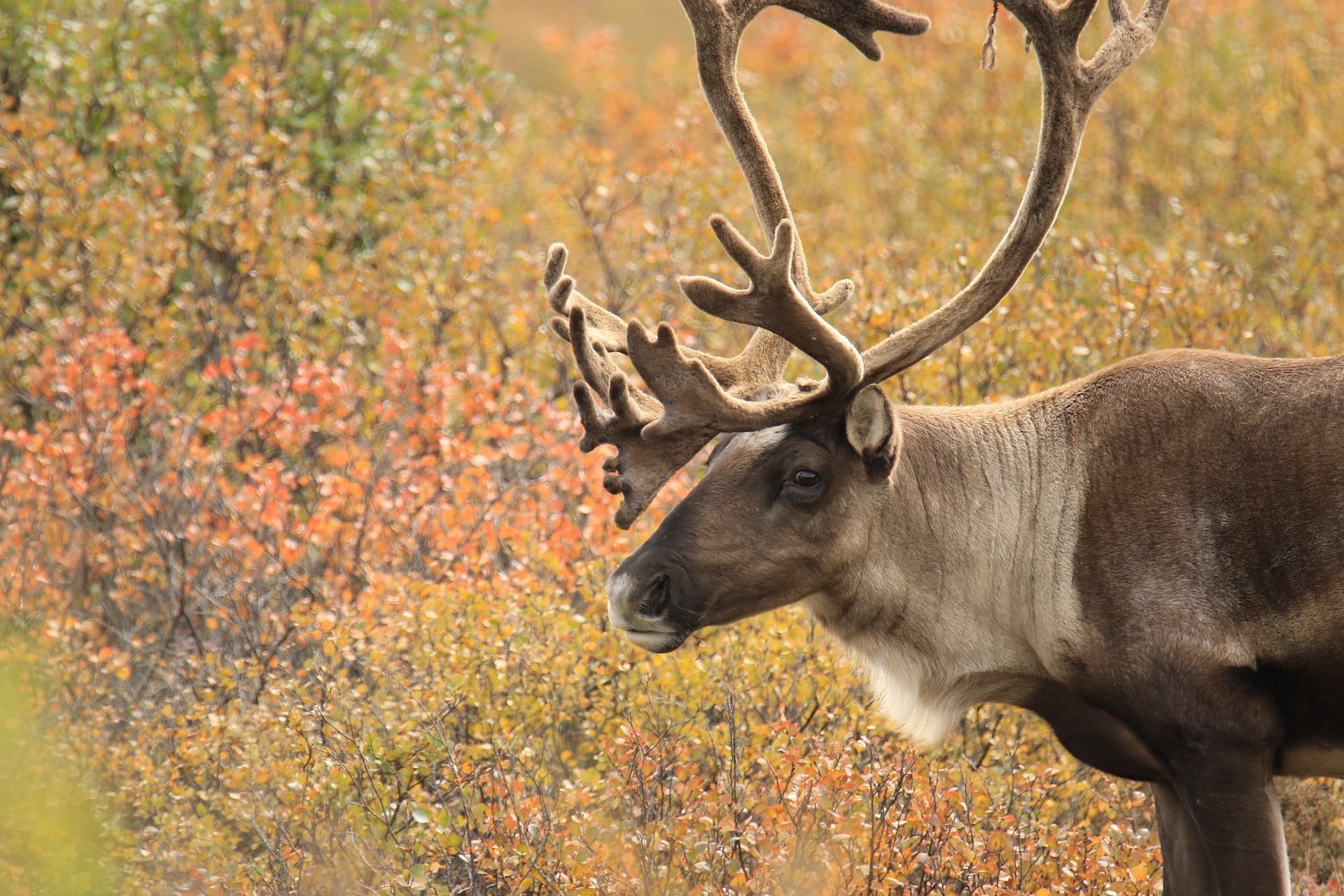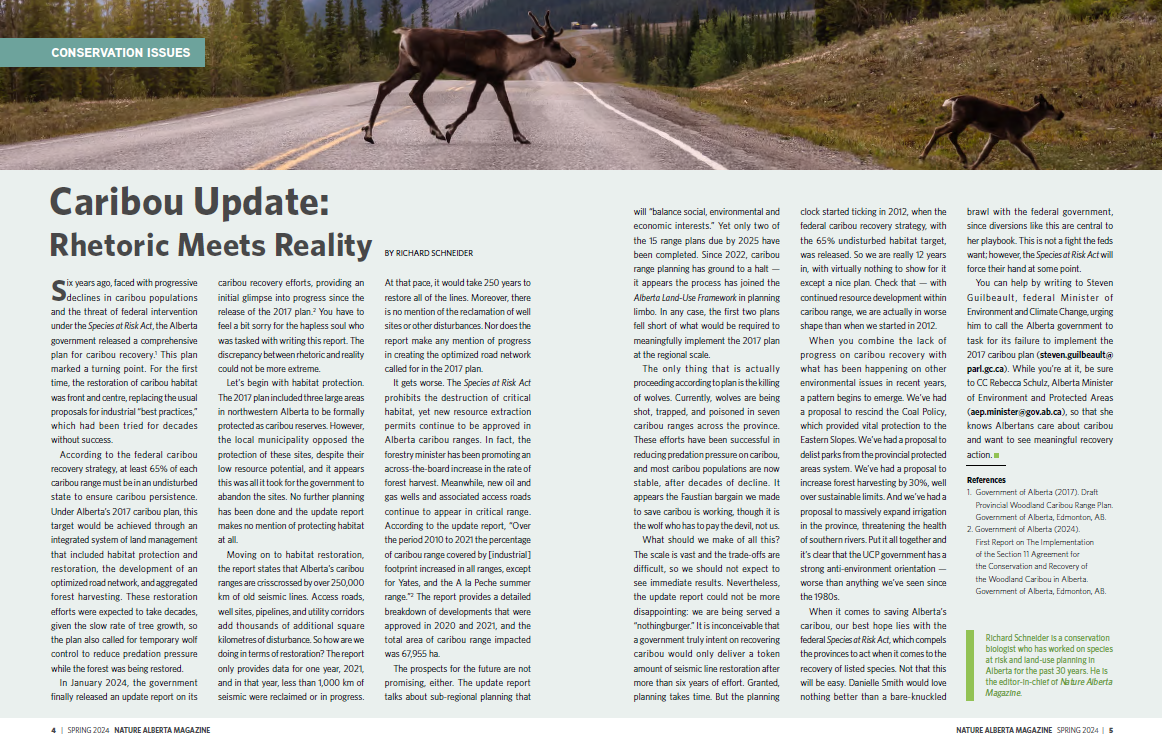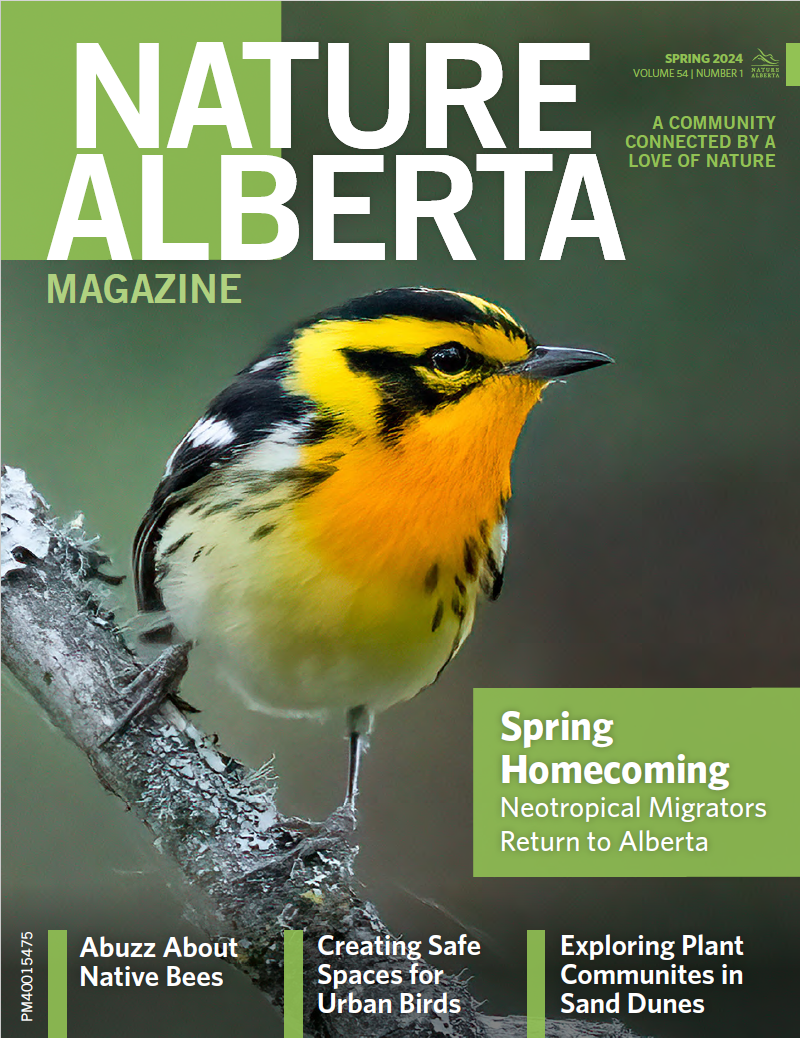Caribou Update: Rhetoric Meets Reality
22 April 2024

BY RICHARD SCHNEIDER
Six years ago, faced with progressive declines in caribou populations and the threat of federal intervention under the Species at Risk Act, the Alberta government released a comprehensive plan for caribou recovery.1 This plan marked a turning point. For the first time, the restoration of caribou habitat was front and centre, replacing the usual proposals for industrial “best practices,” which had been tried for decades without success.
According to the federal caribou recovery strategy, at least 65% of each caribou range must be in an undisturbed state to ensure caribou persistence. Under Alberta’s 2017 caribou plan, this target would be achieved through an integrated system of land management that included habitat protection and restoration, the development of an optimized road network, and aggregated forest harvesting. These restoration efforts were expected to take decades, given the slow rate of tree growth, so the plan also called for temporary wolf control to reduce predation pressure while the forest was being restored.
In January 2024, the government finally released an update report on its caribou recovery efforts, providing an initial glimpse into progress since the release of the 2017 plan.2 You have to feel a bit sorry for the hapless soul who was tasked with writing this report. The discrepancy between rhetoric and reality could not be more extreme.
Let’s begin with habitat protection. The 2017 plan included three large areas in northwestern Alberta to be formally protected as caribou reserves. However, the local municipality opposed the protection of these sites, despite their low resource potential, and it appears this was all it took for the government to abandon the sites. No further planning has been done and the update report makes no mention of protecting habitat at all.
Moving on to habitat restoration, the report states that Alberta’s caribou ranges are crisscrossed by over 250,000 km of old seismic lines. Access roads, well sites, pipelines, and utility corridors add thousands of additional square kilometres of disturbance. So how are we doing in terms of restoration? The report only provides data for one year — 2021 — and in that year, less than 1,000 km of seismic were reclaimed or in progress. At that pace, it would take 250 years to restore all of the lines. Moreover, there is no mention of the reclamation of well sites or other disturbances. Nor does the report make any mention of progress in creating the optimized road network called for in the 2017 plan.
It gets worse. The Species at Risk Act prohibits the destruction of critical habitat, yet new resource extraction permits continue to be approved in Alberta caribou ranges. In fact, the forestry minister has been promoting an across-the-board increase in the rate of forest harvest. Meanwhile, new oil and gas wells and associated access roads continue to appear in critical range. According to the update report, “Over the period 2010 to 2021 the percentage of caribou range covered by [industrial] footprint increased in all ranges, except for Yates, and the A la Peche summer range.”2 The report provides a detailed breakdown of developments that were approved in 2020 and 2021, and the total area of caribou range impacted was 67,955 ha.
The prospects for the future are not promising either. The update report talks about sub-regional planning that will “balance social, environmental and economic interests.” Yet only two of the 15 range plans due by 2025 have been completed. Since 2022, caribou range planning has ground to a halt — it appears the process has joined the Alberta Land-Use Framework in planning limbo. In any case, the first two plans fell short of what would be required to meaningfully implement the 2017 plan at the regional scale.
The only thing that is actually proceeding according to plan is the killing of wolves. Currently, wolves are being shot, trapped, and poisoned in seven caribou ranges across the province. These efforts have been successful in reducing predation pressure on caribou, and most caribou populations are now stable, after decades of decline. It appears the Faustian bargain we made to save caribou is working, though it is the wolf who has to pay the devil, not us.
What should we make of all this? The scale is vast and the trade-offs are difficult, so we should not expect to see immediate results. Nevertheless, the update report could not be more disappointing: we are being served a “nothingburger.” It is inconceivable that a government truly intent on recovering caribou would only deliver a token amount of seismic line restoration after more than six years of effort. Granted, planning takes time. But the planning clock started ticking in 2012, when the federal caribou recovery strategy, with the 65% undisturbed habitat target, was released. So we are really 12 years in, with virtually nothing to show for it except a nice plan. Check that — with continued resource development within caribou range, we are actually in worse shape than when we started in 2012.
When you combine the lack of progress on caribou recovery with what has been happening on other environmental issues in recent years, a pattern begins to emerge. We’ve had a proposal to rescind the Coal Policy, which provided vital protection to the Eastern Slopes. We’ve had a proposal to delist parks from the provincial protected areas system. We’ve had a proposal to increase forest harvesting by 30%, well over sustainable limits. And we’ve had a proposal to massively expand irrigation in the province, threatening the health of southern rivers. Put it all together and it’s clear that the current government has a strong anti-environment orientation — worse than anything we’ve seen since the 1980s.
When it comes to saving Alberta’s caribou, our best hope lies with the federal Species at Risk Act, which compels the provinces to act when it comes to the recovery of listed species.
You can help by writing to Steven Guilbeault, federal Minister of Environment and Climate Change, urging him to call the Alberta government to task for its failure to implement the 2017 caribou plan (steven.guilbeault@parl.gc.ca). While you’re at it, be sure to CC Rebecca Schulz, Alberta Minister of Environment and Protected Areas (aep.minister@gov.ab.ca), so that she knows Albertans care about caribou and want to see meaningful recovery action.
Richard Schneider is a conservation biologist who has worked on species at risk and land-use planning in Alberta for the past 30 years. He is the editor-in-chief of Nature Alberta Magazine.
Read the Original Article for this Post
For a richer reading experience, view this article in the professionally designed online magazine with all images and graphs in place.
This article originally ran in the Spring 2024 issue of Nature Alberta Magazine (Vol. 54 | No. 1).


